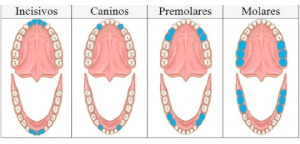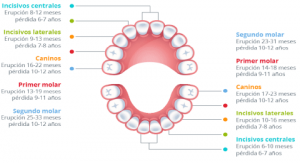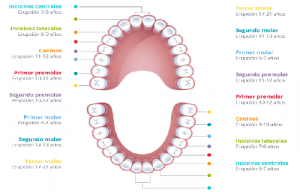The dental eruption corresponds to the mobilization or displacement of the tooth from the inside of the maxillary or mandibular bone to its final position within the buccal arch, culminating with normality this process once a correct occlusion with the antagonist has been achieved. Knowing their evolution and understanding the eruption as a physiological process is of vital importance and serves as a guide to assess the development and growth of childrenIf there are alterations at the eruptive level, they can be coordinated and controlled with the orthodontic specialist who is in charge of guiding the correct growth if needed. Before, the protocol was to intervene with orthodontics once all the definitive teeth had erupted. For some time, it has been shown that in the face of the need to guide and correct bites, dental occlusions or poor positions, the problem is usually solved much easier with orthopedics, which is the branch of orthodontics that guides Growth movements, and not with conventional orthodontics.
TYPES OF DENTITION:
- TEMPORARY DENTITION: It begins at 7-8 months of life with the eruption of the lower central incisors and ends with the eruption of the first premolars, since they expel the last temporary teeth from the arch, which should remain at about 12 years old.
- MIXED DENTITION: It is the transition from the temporary to the final dentition. Mixed dentition is considered when there are temporary teeth and definitive teeth in the same mouth and usually corresponds from 5-6 years old to approximately 12 years old.
- DEFINITIVE DENTITION: When the jaws increase in size, the temporary teeth are replaced by larger teeth, which are designed to be in the mouth throughout life, if there are no problems of major tooth decay, infections, gum problems or traumas, among others. It begins at 5-6 years old with the eruption of the lower central incisors and culminating around 13 years old with the eruption of the second molars.
TYPES OF TEETH:
CHRONOLOGY OF TEMPORARY ERUPTION:
- Central incisors: 7-8 months of life
- Lateral incisors: 11 months of life
- First molar: 15 months of life
- Canines: 19 months of life
- Second molar: 23-24 months
CHRONOLOGY OF DEFINITIVE ERUPTION:
- Lower central incisors: 6-7 years old
- Upper central incisors: 7-8 years old
- Lower lateral incisors: 7-8 years old
- Upper lateral incisors: 8-9 years old
- Upper canine: 11-12 years old
- Lower canine: 9-10 years old
- Upper premolars: 10-12 years old
- First upper and lower molar: 6-7 years old
- Second upper and lower molar: 11-13 years old
There are conditions that alter the tooth eruption, either accelerating the process or delaying it.
FACTORS THAT ACCELERATE DENTAL ERUPTION:
- Fever above 38ºC
- Presence of acute diseases
- Hyperthyroidism. They are some of the most common causes
FACTORS THAT DELAY ERUPTION:
- Presence of chronic diseases
- Presence of diseases that modify the process of calcification or calcium metabolism
- Hypothyroidism
- Presence of endorphin diseases such as hypothyroidism
- Malnutrition, among other causes.
SYMPTOMS OF DENTAL ERUPTION:
We usually associate the tooth eruption with certain symptoms of irritability of the baby. Despite being a normal physiological process, there are mild and controllable alterations that some babies suffer. The eruptive process can be carried out with or without symptoms. Some of these symptoms are:
- Inflammation and redness of the gums
- Irritability for painful areas
- Frequent drooling
- Need to bring objects to the mouth to relieve irritated areas
There is a high range of rubber teethers that can be cooled in the fridge and thus lessen uncomfortable symptoms. But above all, the most important thing is to have a correct control with the pediatric dentist, who is the qualified specialist to guide the correct growth of the arches and assess the dental eruption. We recommend an annual control from the appearance of the first teeth in the mouth.
Dental Clinic Unit / Dr. Jiménez





